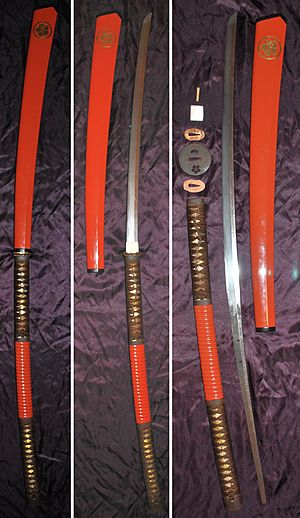Nagamaki facts for kids
The Nagamaki was a special Japanese pole weapon used by Samurai warriors. It had a long, heavy blade attached to a long handle, making it look a bit like a glaive. It was popular in Japan from the late 1100s to the mid-1500s, during periods like the Kamakura and early Muromachi eras.
The Nagamaki's blade was usually about 2 to 4 feet long, and its handle was about 2 to 3 feet long. The blade had only one sharp edge, but the back edge was also sharpened a little to make the weapon lighter.
Contents
What Makes the Nagamaki Special?
The Nagamaki looks a lot like another Japanese pole weapon called a naginata. However, there's a key difference: its handle. Unlike the naginata, which usually had a simple wooden pole, the Nagamaki's handle was built more like the handle of a katana (a traditional samurai sword).
The name "Nagamaki" actually means "long wrapping." This is because its handle was carefully wrapped with cords in a criss-cross pattern, just like a katana handle. This wrapping gave warriors a better grip. The Nagamaki is also seen as a type of no-dachi, which was a very long samurai sword.
How Was the Nagamaki Used?
Warriors held the Nagamaki with both hands in a fixed position, similar to how a katana is held. Unlike the naginata, where hands might slide along the shaft, with the Nagamaki, the hands stayed in place. The right hand was always kept closest to the blade.
The Nagamaki was designed for powerful, wide sweeping and slicing attacks. It could also be used like a spear for thrusting. It was mainly used by infantry (foot soldiers) to fight against horsemen.
Why Wasn't It More Common?
Even though the Nagamaki was a powerful weapon, it wasn't as widely used as spears or naginatas. This was because it took more time and materials to create a Nagamaki. Its use peaked around the middle of the Muromachi period (around the 14th to 16th centuries).
Nagamaki Today
If you want to see something similar to a real Nagamaki today, you might find a nagamaki-naoshi. This is often a long, straight, and thin blade that looks like a katana but has a very long handle. In comparison, a naginata usually has a shorter, wider, and more curved blade.
Images for kids
See also
 In Spanish: Nagamaki para niños
In Spanish: Nagamaki para niños


